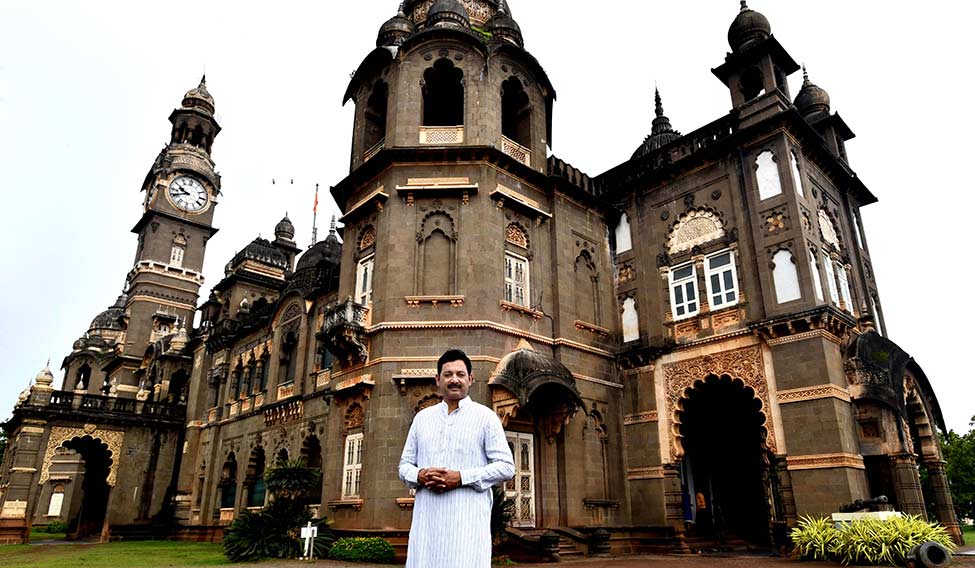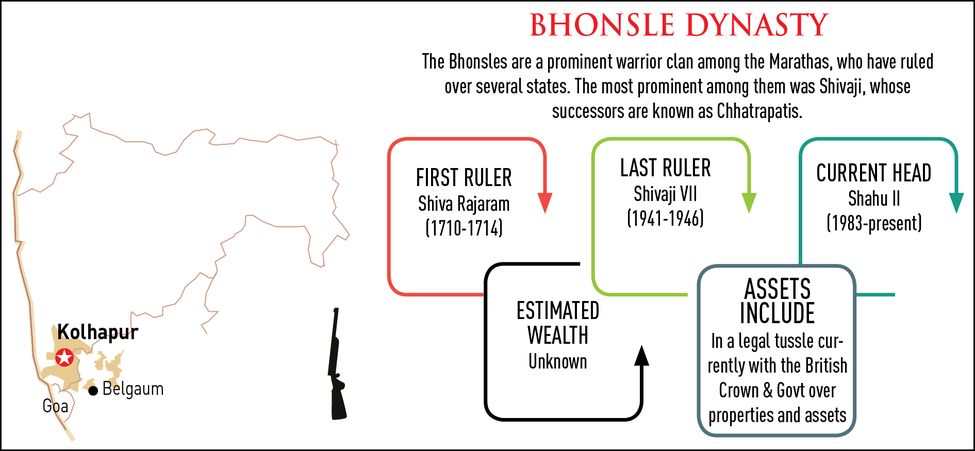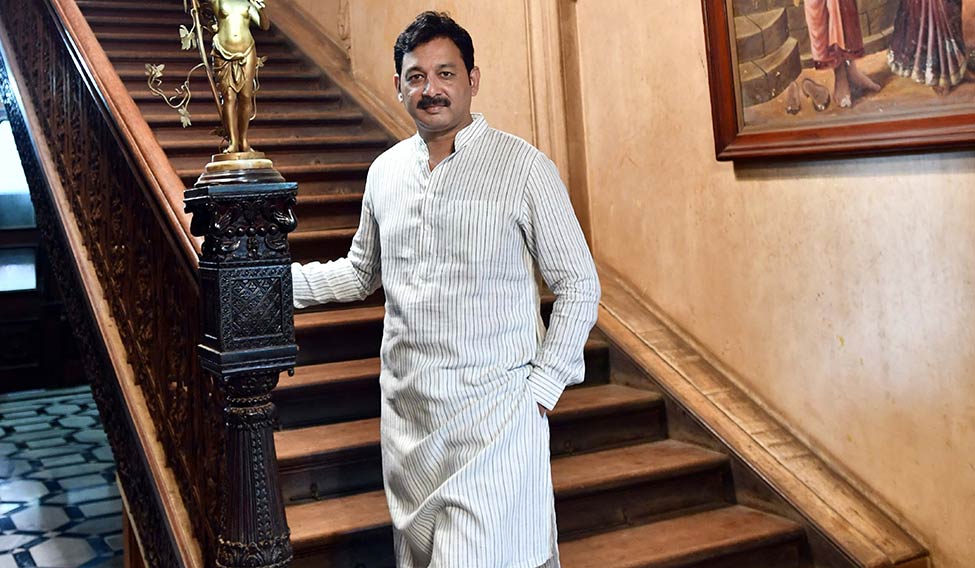It is almost three in the afternoon. Nearly 50 people are waiting in the VIP suite at Tarabai Park, a government guest house in Kolhapur. No minister is scheduled to be there that day; neither are the people waiting for one. They are there to meet Sambhajiraje Chhatrapati, member of the Rajya Sabha, the crown prince of the Kolhapur royal family and the 13th direct descendent of Chhatrapati Shivaji Maharaj, the much worshipped warrior king of Maharashtra.
Sambhajiraje, who was nominated to the Rajya Sabha in June last year, had just returned to Kolhapur in the morning. He had flown in to Pune from Delhi and, past midnight, had boarded the AC compartment of Mahalaxmi Express, the common man’s favourite train to Kolhapur. He could well have driven from Pune, but he chose to sleep in the train, as he had just a little more than a day to spend in Kolhapur.
Among the people waiting to meet him in Kolhapur is a group that has prepared a presentation on the need to restore Shivaji’s forts, a cause that Sambhajiraje has been championing since 2006. “The forts of Shivaji Maharaj are his memorials. We need to preserve and restore them. The Statue of Liberty-like memorial in the sea, [which the government is planning to build] off the Mumbai coast, is also necessary. But we must not ignore our forts…. I have decided to pick five of the most important among them and restore them to full glory,” he tells THE WEEK.
A 46-year-old management graduate, Sambhajiraje is the first from his family to enter Parliament. His younger brother Malojiraje was a member of the Maharashtra assembly from 2009 to 2014. In 2009, Sambhajiraje contested Lok Sabha election as a Nationalist Congress Party candidate, but lost. His wife, Sanyogitaraje, belongs to the Damtari royal family. Their only son, Shrimant Shahajiraje, 20, is a student.
Kolhapur and Satara are the most important royal families in Maharashtra. Chhatrapati Shivaji had two sons—Sambhaji and Rajaram. After Shivaji’s death in 1680, Sambhaji took over the reins of the ‘Swarajya’ and continued to fight Mughal emperor Aurangzeb, who by then had descended upon Deccan to crush the Marathas. After Sambhaji was caught and murdered on Aurganzeb’s orders in 1689, his younger brother Rajaram became Chhatrapati. He continued the fight till his death in 1700.
The battle against Aurangzeb went on under the leadership of Rajaram’s widow, Tarabai. When Aurganzeb died in 1707, Shahu, Sambhaji’s son, who had been held captive by the Mughals, was released and allowed to return to Maharashtra. He settled in Satara. A peace treaty signed on the banks of the river Warna in 1734 led to the formation of Satara and Kolhapur houses as independent Maratha kingdoms. Shahu was king of Satara with peshwas as his prime ministers, while the Kolhapur throne was ruled by descendants of Rajaram. The kingdoms were separate, and there was no senior-junior distinction between them, as had been the case with some princely states. The British annexed the Satara throne under the ‘doctrine of lapse’ policy in 1849, but Kolhapur remained a ‘19-gun salute’ princely state.
One of the most famous rulers of Kolhapur was Chhatrapati Shahu Maharaj, who, in 1902, became the first Indian king to implement a policy of reservation for socially and economically backward people, including Muslims. Sambhajiraje, the present-day crown prince, is the fifth descendent of Shahu.
Shahu Maharaj did immense work for his people. He brought railway to Kolhapur, constructed a dam at Radha Nagri, began land reforms and encouraged dalits to become entrepreneurs. It is said that whenever he stepped out of his palace, he would stop by a canteen started by a dalit and have tea and snacks.
 learning curve: Sambhajiraje says he considers Parliament as his school | Janak Bhat
learning curve: Sambhajiraje says he considers Parliament as his school | Janak Bhat
“When Shahu Maharaj implemented reservation, it included Marathas, too. He knew that just about 30 per cent of Maratha families were well off and the rest needed the state’s helping hand,” says Sambhajiraje, who has been organising young Marathas to create a pressure group to secure reservation for them. Recently, he also raised the issue of Maratha reservation in Parliament.
“As the scion of the most important royal family, my job is to create leaders from the young generation,” he says. “It was Shahu Maharaj who told dalits in Kolhapur that Dr [B.R.] Ambedkar was their true leader. He then gave his own sapha [traditional headgear] to Ambedkar at a function.”
How did he join the BJP? “After 2009, I was left with two choices—either return to the palace and live like any other crown prince, or live among the people, understand their issues and bring them together. I chose to take the second option. I tried in my own way to bring ‘bahujan samaj’ together,” says Sambhajiraje.
And his work came to the notice of Chief Minister Devendra Fadnavis. “He called me last year. He told me that the BJP would like to honour our family and have me in the Rajya Sabha. People run after top leaders to be an MP; here I was being offered the position. As our family has never been associated with the BJP, I told him to wait and give me some time,” he says.
Three days later, Fadnavis called him again and informed him that Prime Minister Narendra Modi would like to meet him. “When I went to New Delhi, the prime minister told me he would like to honour our family,” says Sambhajiraje. “He said Shivaji Maharaj and Shahu Maharaj are not limited to Maharashtra alone. ‘They are India’s leaders,’ he said, ‘and that is why we would like to honour your family by nominating you to the Rajya Sabha.’”
When news of his nomination broke, NCP chief Sharad Pawar caustically remarked: “In the old days, Chhatrapati used to appoint a Fadnavis [a post equivalent to finance minister in the peshwa rank]. Nowadays, a Fadnavis is appointing Chhatrapati.”
Explaining that he had been acting on the prime minister’s instructions, Fadnavis gave a classic rejoinder. “In the old days, Fadnavis carried messages to Chhatrapati,” he said. “I, too, have done the same and carried the prime minister’s message to Chhatrapati Sambhajiraje. I remain a humble messenger of the cause championed by Shivaji and his family.”
Sambhajiraje says his family was not affected by the abolition of privy purses. “Kolhapur royal family never did anything for themselves. Neither Shahu Maharaj nor did any of his descendents, including my father, start any private enterprise. We don’t have hotels,” he says. “As I remember it, we used the privy purse for the people and for maintaining our palace. Today, [when] we see people flaunt money, we feel a little bit of pinch, but we are happy. I don’t require a Rolls-Royce; I am happy with a good car. I have a Mercedes, but I also use a Ford. That’s how we have been brought up.”
Not much is known about the wealth of the Kolhapur royals. The family has houses in Pune and Mumbai’s Malabar Hill. They also own farmland in the district and elsewhere in Maharashtra. Sambhajiraje also owns land in Raybag in Karnataka, which was part of the Kolhapur princely state. “I have made sure that it remains under cultivation,” he says. “I go there whenever I get time.”
The family runs a school in Kolhapur and manages the affairs of All India Shri Shivaji Memorial Society, which runs a number of educational institutions in the state, including a military school, a polytechnic institute, and an engineering and management college.
Raigad, the fort where Shivaji Maharaj was crowned as a sovereign king in 1674, is very dear to Sambhajiraje. He wants it to be restored to its old glory. “Every year, we organise a function at Raigad,” he says. “Last year, the CM also came and he was impressed. He has sanctioned Rs 600 crore for the development and restoration of Raigad, including the construction of an excellent road from Mahad to the foothills of the fort.”
He says he believes in the teachings of Shivaji Maharaj, Shahu Maharaj, Ambedkar and social reformer Jyotirao Phule. “Their thoughts are my ideology. Today, I support the BJP in Parliament. But one must remember that the NCP and the Congress never thought about honouring our family. Also, by supporting the BJP, I get things done for Kolhapur and Maharashtra,” says Sambhajiraje.
He is working with the railway ministry to get a Shatabdi Express on the Kolhapur-Pune route. “Being an MP is a tough job. I consider Parliament as my school. I am just beginning and I have 100 per cent attendance,” he says proudly.
Sambhajiraje is a cricket enthusiast, unlike his father, Shahu Maharaj, the current head of the Kolhapur family. “My father loves football,” says Sambhajiraje. “He never misses a football match. We even have a football stadium here in Kolhapur. I like football, but my passion is cricket.”
As a management graduate, there are occasions when he feels that he should have chosen a corporate career. “But then I realise that I was always more involved in the social side,” says Sambhajiraje. “I must tell you that my son thinks like a businessman. But he, too, has to shoulder the responsibility and carry on the legacy.”
Will he allow Shrimant Shahajiraje to marry a commoner? “I cannot stop him from marrying anyone he likes,” says Sambhajiraje. “I will tell him to get married to a Maratha girl; but then, whatever he decides would be final. I would not dictate his choices.”








